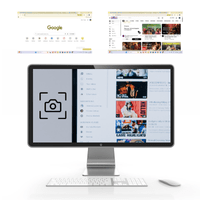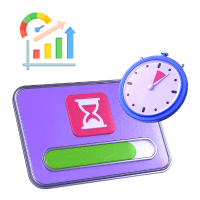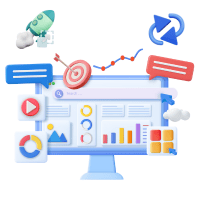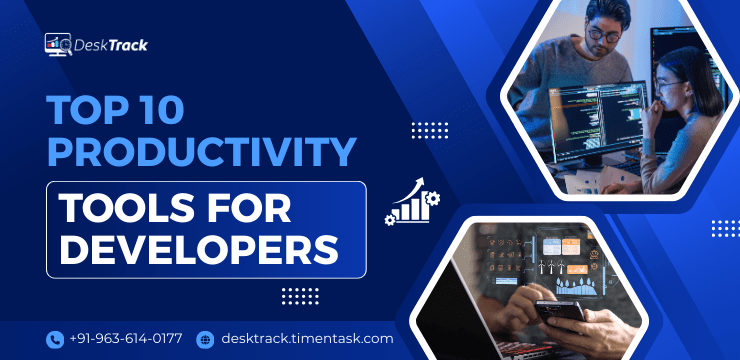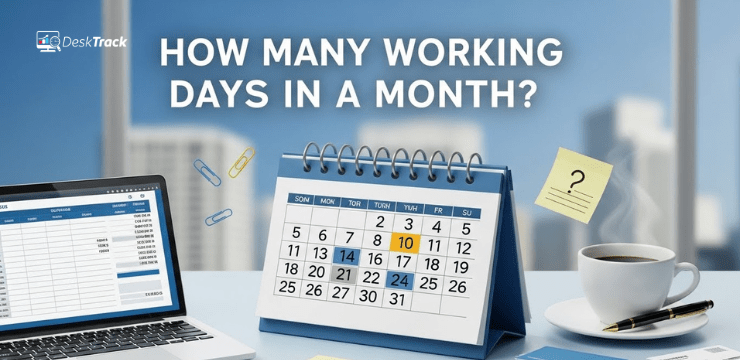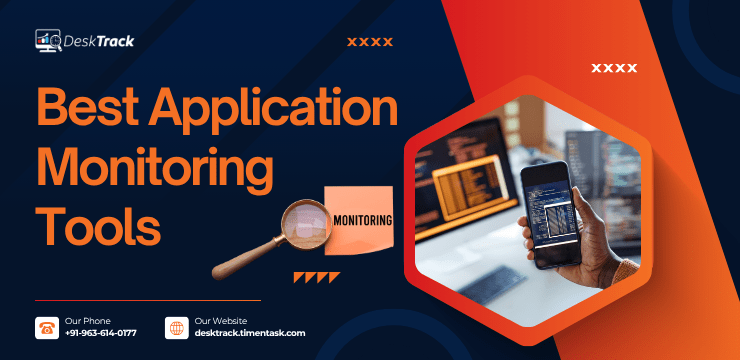
In today’s on-demand world, consistent performance and uptime are critical to digital success. Users expect apps to load instantly and never fail. To meet these expectations, businesses turn to the best application monitoring tools that can track performance, detect errors, and prevent downtime before users even notice. These tools are vital in 2025, whether your architecture is cloud-native, microservices-based, or monolithic.
This blog reviews the top 10 best application monitoring tools of 2025—featuring standout solutions like Datadog, Dynatrace, Sentry, and now DeskTrack, which uniquely combines employee and application tracking. With detailed features, pros and cons, and use cases, this guide helps DevOps engineers, CTOs, and tech teams confidently choose the right monitoring tool. Each section includes clear descriptions and practical advice on selecting tools for your stack and business goals.
What Are Application Monitoring Tools?
Monitoring tools give insight into app behavior, performance, and health. Knowing what qualifies as the best application monitoring tools helps you evaluate which solution fits.
Definition & Core Purpose
Application monitoring tools continuously track metrics like response time, error rates, and throughput to ensure your application runs smoothly.
These tools collect real‑time data on application performance, giving teams visibility into how code behavior impacts end users.
Types of Monitoring
Includes real‑user monitoring, synthetic tests, infrastructure, logs, and distributed tracing.
A comprehensive approach combines multiple monitoring types to capture performance from user experience to backend operations.
Performance Metrics Tracked
Common metrics include latency, CPU/memory usage, database query times, error counts, and request throughput.
Tracking these metrics helps detect anomalies, resource bottlenecks, or unusual trends before they escalate.
Integration with Alerting Systems
Monitors integrate with Slack, PagerDuty, email, or custom webhooks for real‑time notifications.
Automated alerts ensure teams are notified the moment issues arise, enabling faster response and remediation.
Role in DevOps & SRE
They support continuous improvement by identifying bottlenecks and enabling rapid rollbacks or fixes.
Monitoring tools provide feedback loops critical for DevOps practices and improving reliability (SRE).
Read Also: Is Employee Monitoring Software an Invasion of Privacy? Debunking Myths
Best Application Monitoring Tools: Why Performance & Uptime Matter in 2025
In 2025’s digital-first era, reliability builds trust and revenue. Investing in the best application monitoring tools ensures performance, uptime, and user satisfaction.
User Expectations Have Evolved
Users expect sub-second load times and near-perfect uptime—even for small apps.
Slow apps lead to abandonment, reduced engagement, and lost conversions.
Microservices & Distributed Systems Complexity
Modern systems often span multiple services, containers, and cloud providers.
Monitoring tools must trace calls across distributed components to pinpoint issues.
Cost of Downtime
Every minute of downtime equals revenue loss, user complaints, and decreased trust.
Even a short outage can impact sales sites, SaaS dashboards, or critical features.
Impact on SEO & Reputation
Downtime and slow performance hurt SEO rankings and brand perception.
Search engines favor fast, reliable sites; slow pages drop in ranking and credibility.
Real-Time Root Cause Detection
Top monitoring tools detect anomalies instantly, helping resolve issues before they affect users.
Early detection prevents escalation and keeps the user experience seamless.
Key Features of Application Monitoring Tools in 2025
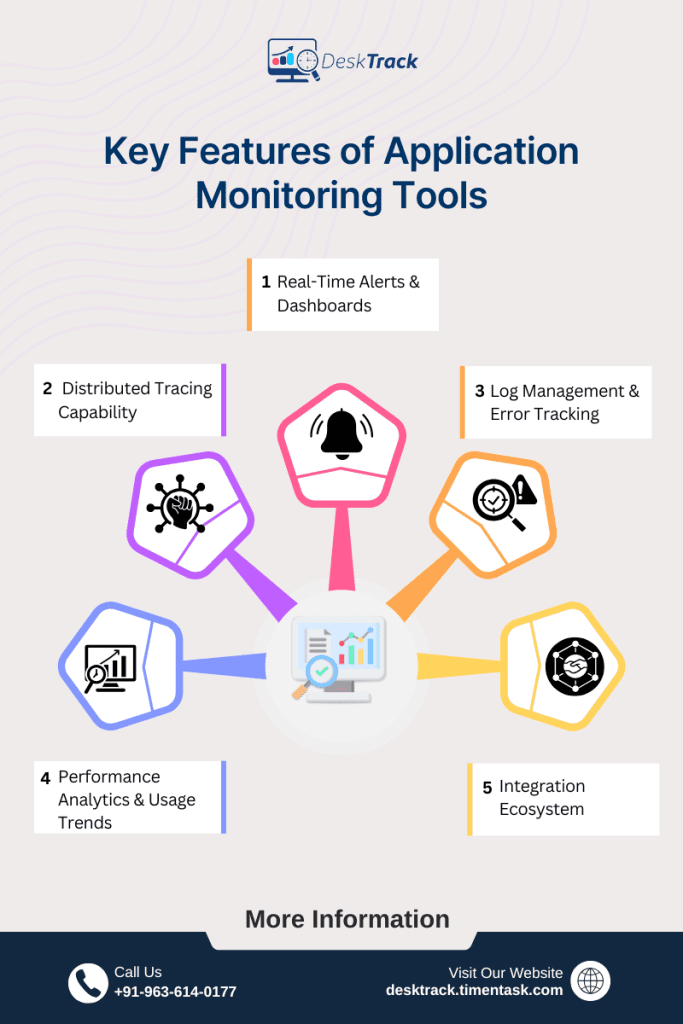
When comparing the best application monitoring tools, prioritize these core features for modern observability needs.
Real-Time Alerts & Dashboards
Live, customizable dashboards help detect issues instantly and provide visual context.
Visual snapshots of traffic, error spikes, and resource usage make problem identification easier.
Distributed Tracing Capability
Trace requests across microservices to locate bottlenecks and errors in complex architectures.
Tracing reveals the path of service calls, helping pinpoint latency or failure points.
Log Management & Error Tracking
Unified logs and error tracking allow central visibility into backend issues and exceptions.
Aggregated logs make debugging faster and more efficient, especially across distributed systems.
Performance Analytics & Usage Trends
Analyze long-term trends to optimize performance and forecast scaling needs.
Insights into seasonal traffic or resource spikes help with proactive planning.
Integration Ecosystem
Integration with Kubernetes, CI/CD, cloud platforms, and third-party APIs enhances flexibility.
The best tools support easy connectivity with existing infrastructure and workflows.
Top 10 Tools Reviewed of Application Monitoring Tools
Make your workday more productive
Time tracking and work management can help you reach your goals
faster.
Here are the top 10 best application monitoring tools in 2025, with DeskTrack replacing New Relic.
DeskTrack
- Features: Combines application performance, user behavior analytics, screenshots, and time tracking
- Pros: Unified view of application health and team activity; easy onboarding; real-time alerts
- Cons: Less traditional APM depth compared to specialized tools
- Use Case: Suitable for teams that need both performance monitoring and user productivity tracking in one platform.
DeskTrack is unique—it merges employee and application monitoring, providing a holistic view of both system health and team performance, ideal for hybrid teams.
Datadog
- Features: Full-stack monitoring, log management, synthetic testing, tracing
- Pros: Scalable, rich integrations, extensive dashboards
- Cons: Pricing complexity for large-scale deployments
Datadog supports wide-ranging environments and is ideal for complex observability use cases.
AppDynamics
- Features: Business transaction tracking, performance analytics, AI anomaly detection
- Pros: Direct mapping between technical metrics and business KPIs
- Cons: Premium pricing and enterprise focus
AppDynamics blends performance monitoring with business context—perfect for enterprise environments.
Dynatrace
- Features: Automated infrastructure discovery, AI-powered root cause detection, full-stack visibility
- Pros: Very high automation and precision in error detection
- Cons: Higher cost and steeper learning curve
Dynatrace excels in fully automated monitoring for large distributed systems.
Sentry
- Features: Error tracking, performance monitoring, release tracking, developer-focused UI
- Pros: Affordable, intuitive, and open-source foundation
- Cons: Limited infrastructure or server-level insights
Sentry is ideal for developer-centric error visibility, especially in startups and small teams.
Prometheus + Grafana
- Features: Time-series metrics, dashboards, alerting, customizable visuals
- Pros: Open-source flexibility, strong community
- Cons: DIY configuration, more technical setup
Prometheus with Grafana offers flexibility for teams comfortable building custom monitoring stacks.
Splunk APM
- Features: Log-driven analytics, performance monitoring, SIEM integration
- Pros: Enterprise-tier insights and compliance support
- Cons: Expensive and complex licensing
Best for organizations requiring tight security monitoring and log auditing.
Site24x7
- Features: Application, server, website, infrastructure monitoring, synthetic tests
- Pros: User-friendly, affordable for SMBs
- Cons: Less rich for deep microservices environments
A great fit for small-to-midsize businesses needing unified monitoring across infrastructure and performance.
LogicMonitor
- Features: Infra and app monitoring, network performance, granular reporting
- Pros: Custom dashboards, hybrid/cloud support, alerts
- Cons: Rapid cost scaling
Useful for mid-to-large teams needing flexible monitoring across servers and apps.
Instana
- Features: Auto-discovery of services, real-time tracing, code-level diagnostics
- Pros: Real-time visibility designed for containerized environments
- Cons: Resource-heavy, premium pricing
Instana provides deep, automated monitoring optimized for modern container-based stacks.
Best Application Monitoring Tools: How to Choose the Right One for Your Stack
Choosing among the best application monitoring tools depends on your system architecture, team capacity, and business goals.
Team Size & Expertise
Large teams benefit from feature-rich tools like Datadog or Dynatrace, while startups may prefer lightweight options like Sentry or DeskTrack.
Tool complexity should match your team’s ability to manage and derive value.
Application Complexity
Simple applications work well with synthetics or log monitoring; distributed systems need tracing and full-stack visibility.
Ensure the tool supports the complexity level of your architecture.
Deployment: Cloud vs On‑Premise
Select tools that support your infrastructure model—cloud-native, hybrid, or on-premise.
Compatibility ensures seamless deployment and avoids unexpected integration issues.
Scalability & Pricing Model
Review cost scaling by hosts, data ingestion, or retention to avoid billing surprises as you grow.
Understand how pricing evolves as your metrics volume increases.
Support & Community
Tools with strong documentation, support, and active user communities reduce friction and speed adoption.
Vendor responsiveness and user forums contribute to smoother onboarding and troubleshooting.
Best Application Monitoring Tools: Real‑World Use Cases & Success Stories
Examples illustrate how the best application monitoring tools drive tangible outcomes.
eCommerce Platform Gains 20% Faster Response
Datadog helped identify database latency and improved checkout performance, boosting conversions.
Real-world data-backed decisions to rearchitect slow database queries.
SaaS Startup Cuts Errors with Sentry
Sentry tracked release regressions, reducing user‑reported bugs by 30%.
Developers fixed issues quickly based on real error visibility.
Fintech Firm Reduces Downtime via Dynatrace
AI-assisted root cause detection in Dynatrace shortened incident resolution time by half.
Automation minimized manual triage and resolved issues faster.
Media Company Uses Prometheus/Grafana for Forecasting
Custom dashboards visualized traffic surges, enabling proactive infrastructure scaling.
Observability supported capacity planning during traffic spikes.
Enterprise Uses AppDynamics for Revenue Insights
AppDynamics connected performance metrics to revenue KPIs, prioritizing fixes by impact.
Cross-functional teams used monitoring data to align engineering with business goals.
Best Application Monitoring Tools: Pros & Cons Summary

A summary of strengths and tradeoffs across the best application monitoring tools.
Pros
- Increased visibility into system health and reliability
- Faster detection and remediation of slowdowns or outages
- Improved user experience and service uptime
- Data-driven decision-making and efficiency gains
Monitoring empowers teams to act before customers notice issues.
Cons
- Higher costs as usage scales
- Complexity in configuring comprehensive monitoring
- Potential alert fatigue if rules aren’t tuned
- Data privacy considerations, if not managed properly
Tool selection should balance value with manageable complexity.
Best for Small Teams
Tools like Sentry, Site24x7, or DeskTrack offer excellent entry points with low overhead.
Ideal for agencies, SMBs, or startups without heavy DevOps overhead.
Best for Enterprises
Dynatrace, Datadog, and AppDynamics deliver advanced features for large-scale deployments.
Enterprises benefit from automated capabilities, AI insights, and enterprise SLAs.
Cost vs Capability Tradeoff
Higher-priced tools offer deeper insights; assess ROI based on uptime improvement versus tool cost.
Choose a tool where operational savings outweigh subscription fees.
Read Also: Project Management vs Time Tracking: Which One Do You Need in 2025?
Best Application Monitoring Tools: Features to Prioritize in 2025
Future-focused features define the standout best application monitoring tools of today.
AI-Powered Anomaly Detection
Machine learning models detect anomalies, performance regressions, and unusual usage patterns.
AI-driven detection prevents major incidents before they impact users.
Serverless & Kubernetes-Aware Monitoring
Support for containers, serverless workloads, and orchestration platforms ensures comprehensive visibility.
Monitoring should cover dynamic, automated systems reliably.
Lightweight Agents & Scalability
Agents must be efficient to avoid impacting performance while allowing horizontal scale.
High-overhead tools can degrade performance themselves, choose lightweight options.
Custom Dashboards & Rule-Based Alerts
Visual custom dashboards and flexible alert rules help align monitoring with team workflows.
Alerts should prioritise business-critical deviations and reduce noise.
Multi-Cloud & Hybrid Support
Tools should monitor cloud and on-prem environments seamlessly for unified observability.
Organizations operating across multiple providers need unified monitoring across environments.
Conclusion
In conclusion, selecting among the best application monitoring tools in 2025 depends on your needs and team capabilities. Light tools like Sentry, Site24x7, or DeskTrack offer ease of use and cost-efficiency for small or distributed teams. More advanced platforms like Datadog, Dynatrace, and AppDynamics cater to larger, distributed systems with AI-powered insights and enterprise dashboards. DeskTrack stands out by combining application monitoring with team activity tracking, enabling a full view of both system health and human workflow in one platform. By focusing on performance metrics, uptime, AI anomaly detection, and infrastructure scalability, you ensure a reliable user experience and optimized operations. Choose a tool that aligns with your stack, budget, and growth plans—and test it thoroughly via trials or pilot runs. A well-implemented monitoring strategy pays off quickly by preventing outages, improving performance, and building trust with your users and stakeholders in 2025 and beyond.
Frequently Asked Questions (FAQ)
Q. What is the best free application monitoring tool?
Ans. Open-source options like Prometheus + Grafana or the free tier of Sentry provide a strong baseline visibility without cost.
Q. Is DeskTrack suitable for mobile applications?
Ans. Yes, DeskTrack supports mobile performance tracking and user behavior analytics through its mobile SDK.
Q. Can these tools monitor serverless environments?
Ans. Top solutions like Datadog, Dynatrace, and DeskTrack offer native support for AWS Lambda, Azure Functions, and GCP Cloud Functions.
Q. How expensive are enterprise-grade monitoring tools?
Ans. Enterprise pricing often starts in the thousands per month. Small-tier tools may be free or low-cost—costs scale with data usage and user count.
Q. Can small teams manage setup without a dedicated DevOps engineer?
Ans. Yes, Lightweight tools like DeskTrack, Sentry, or Site24x7 often feature guided setup and minimal configuration needs, making them accessible for small teams.




